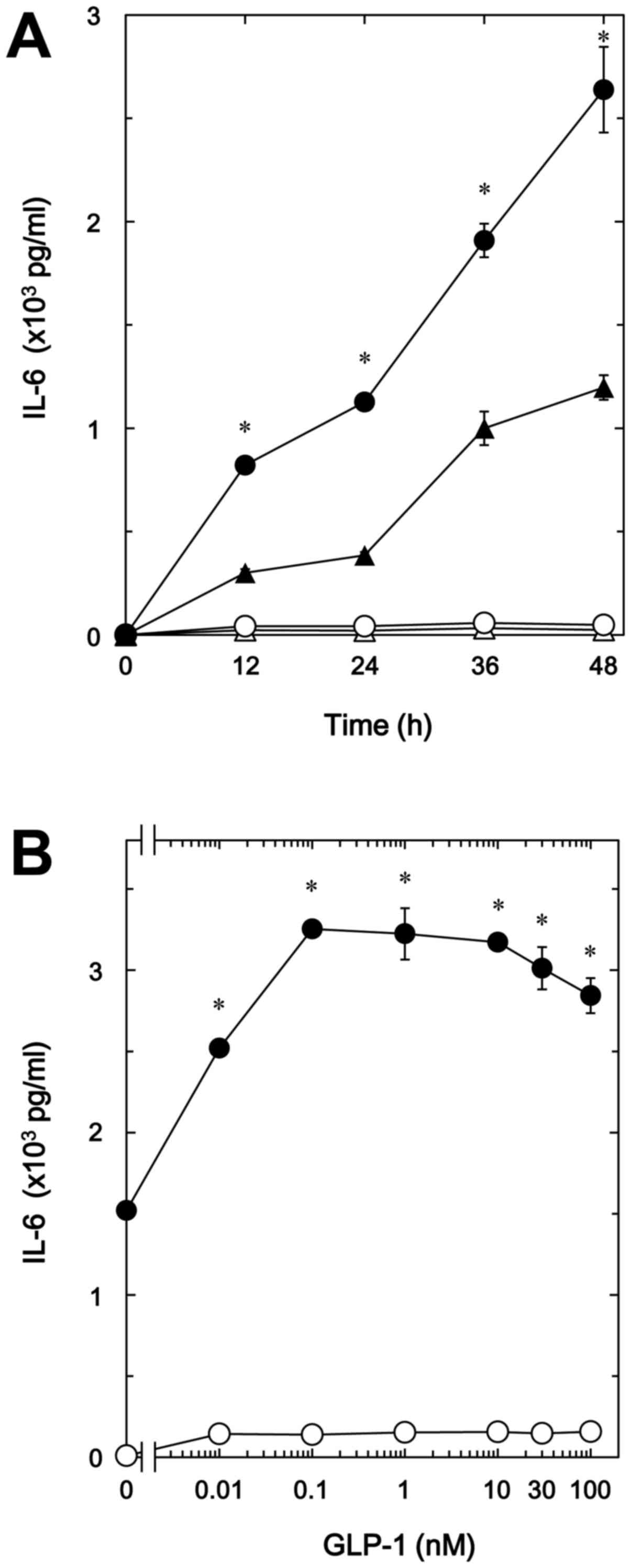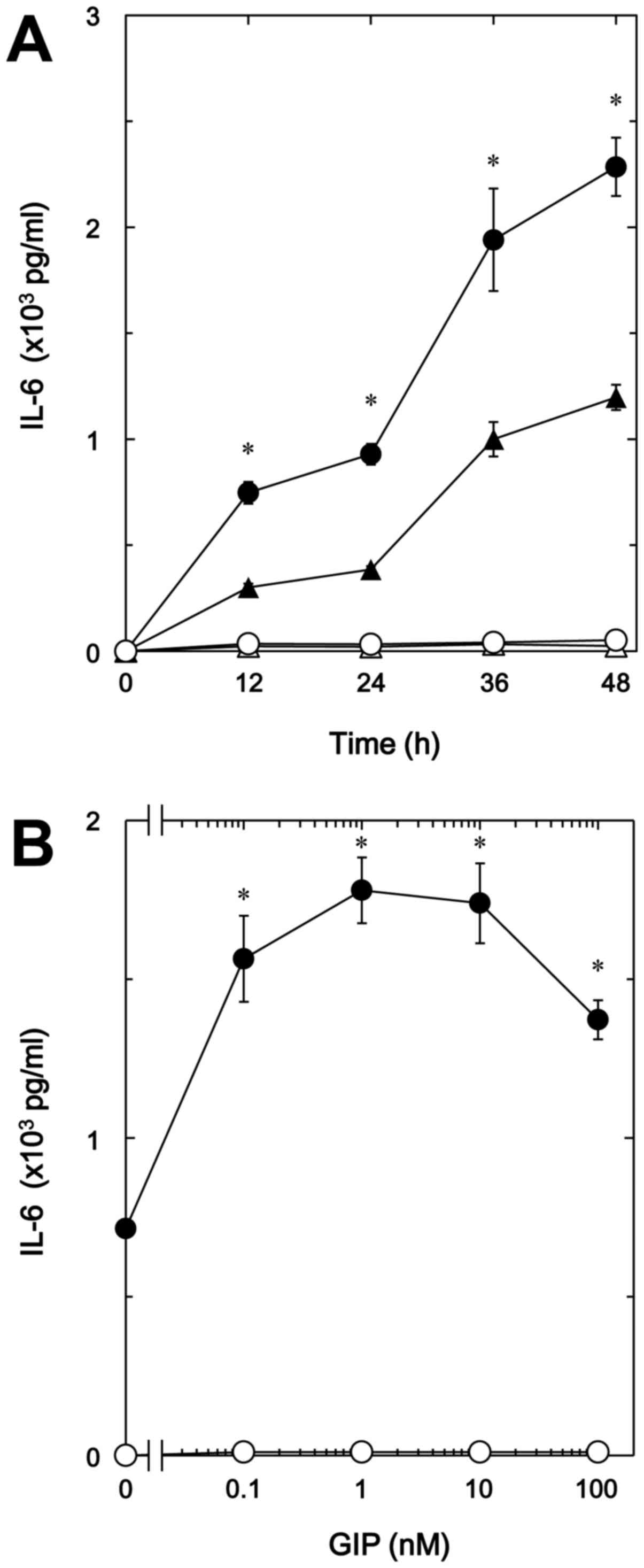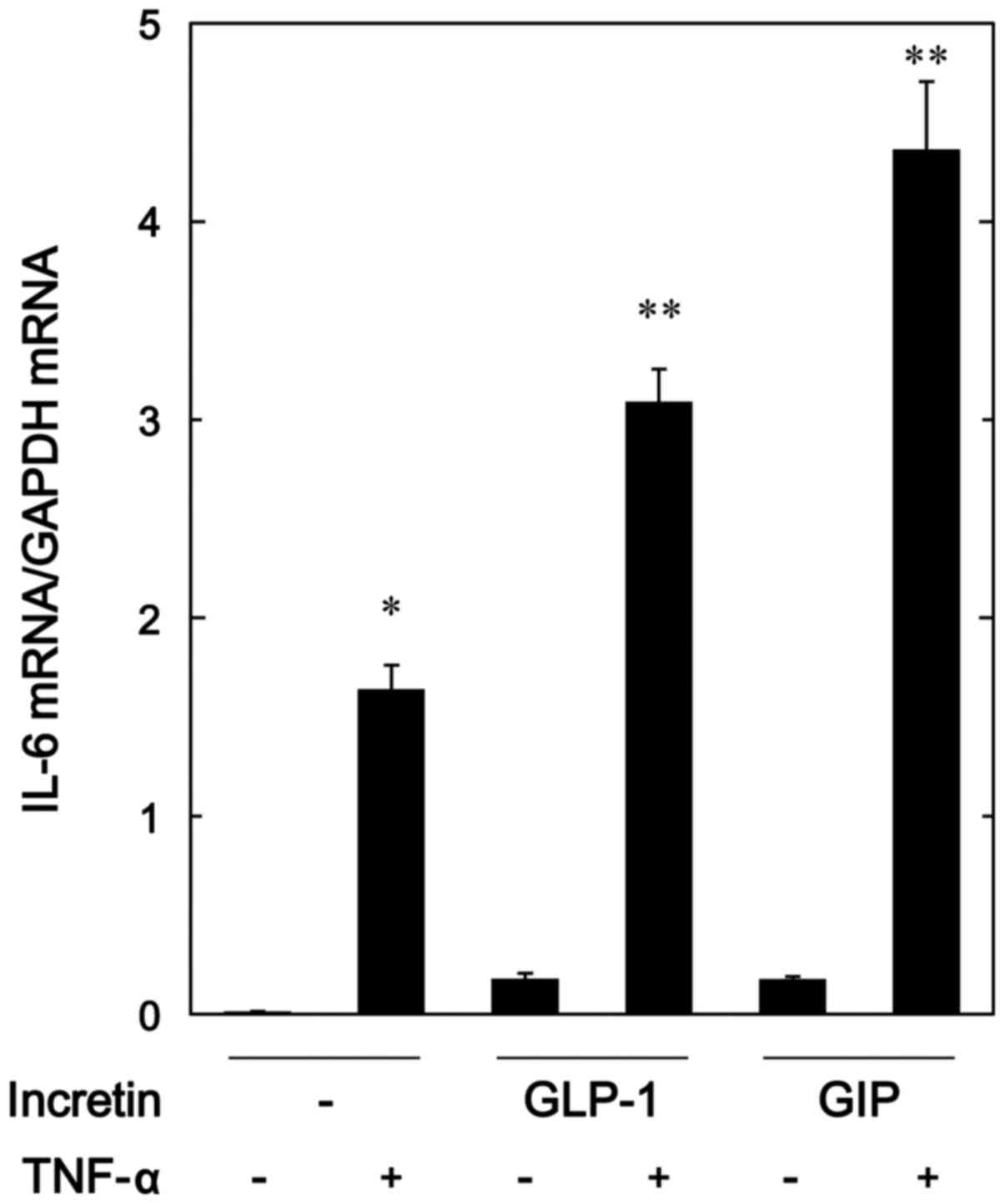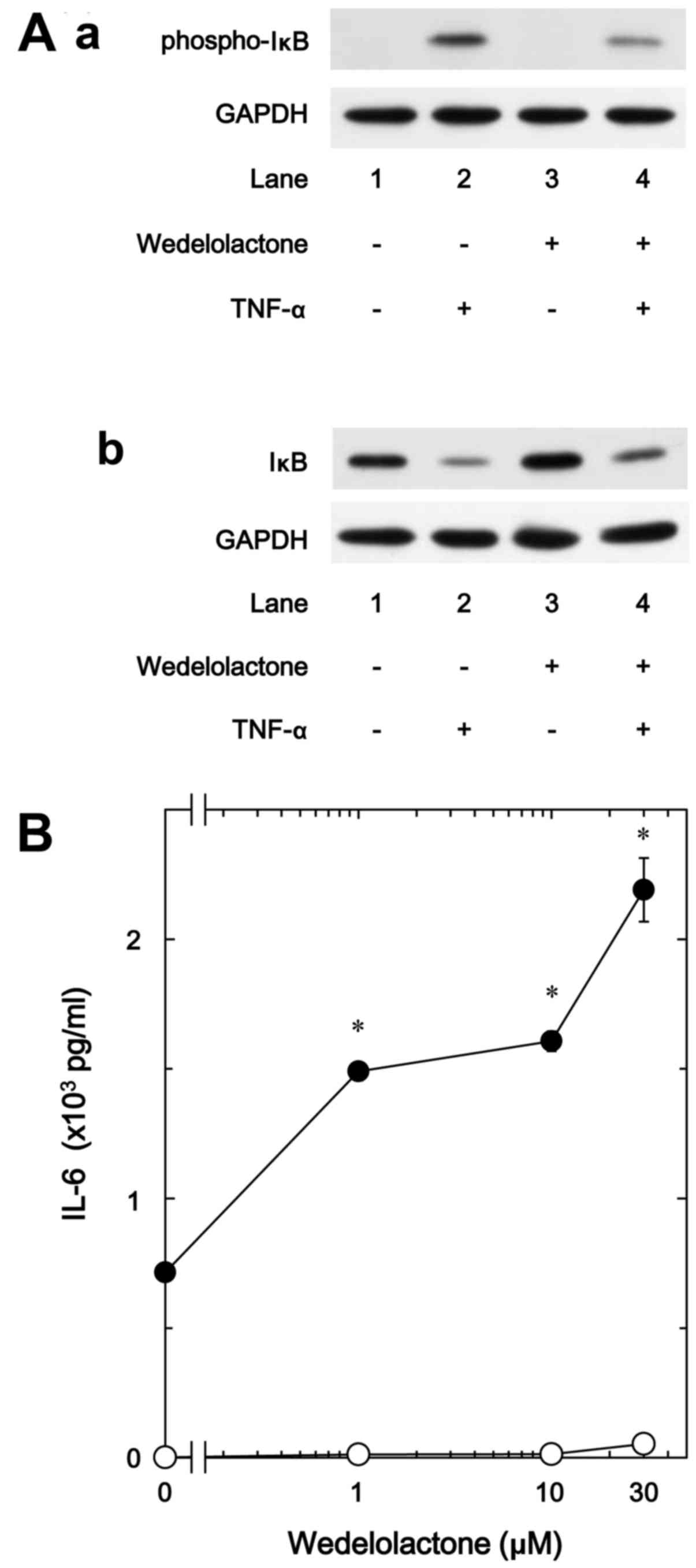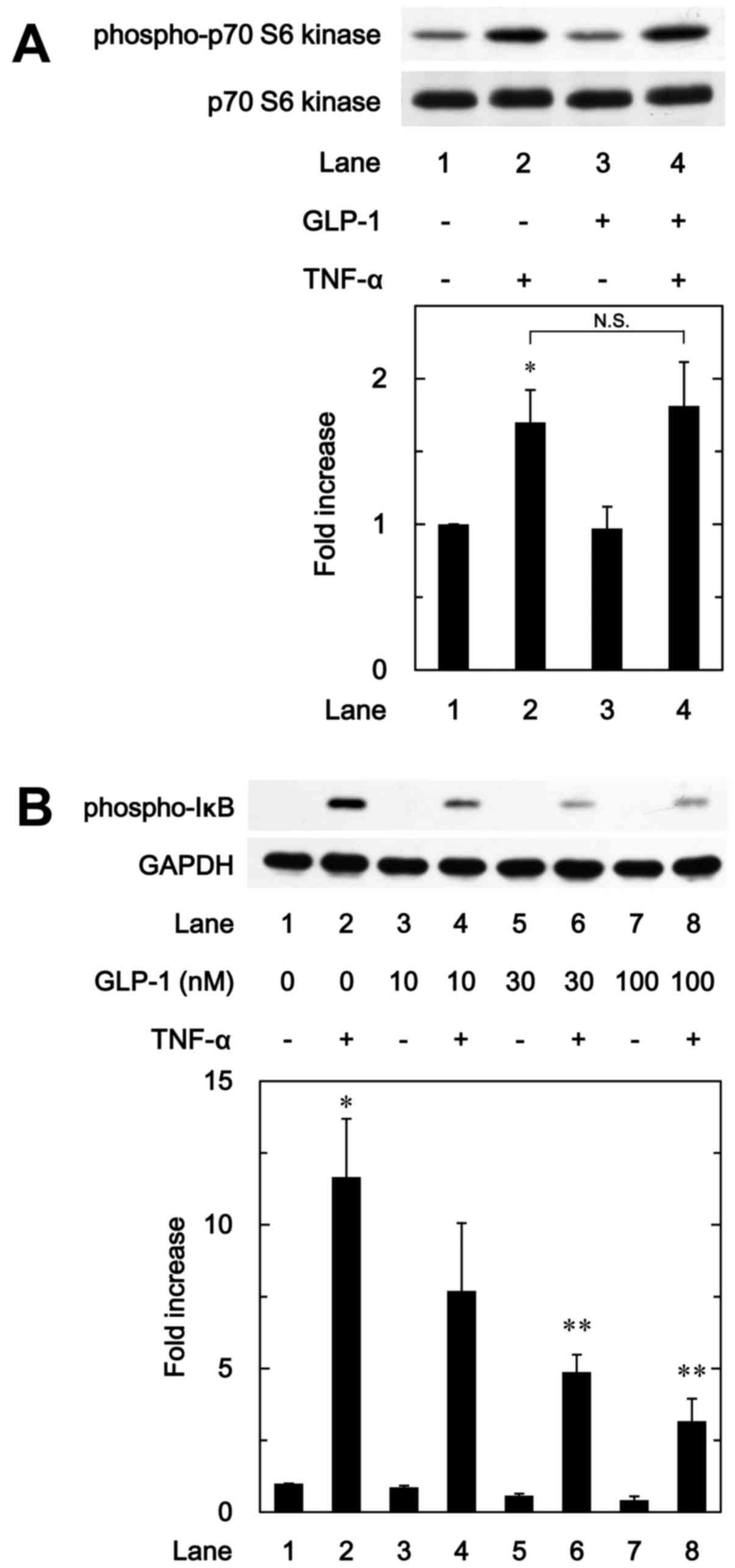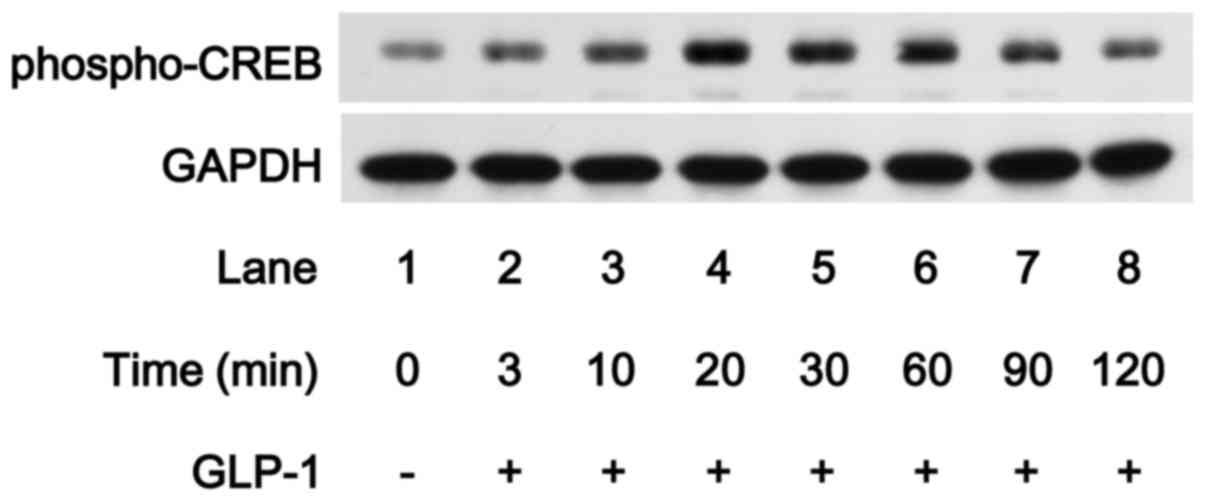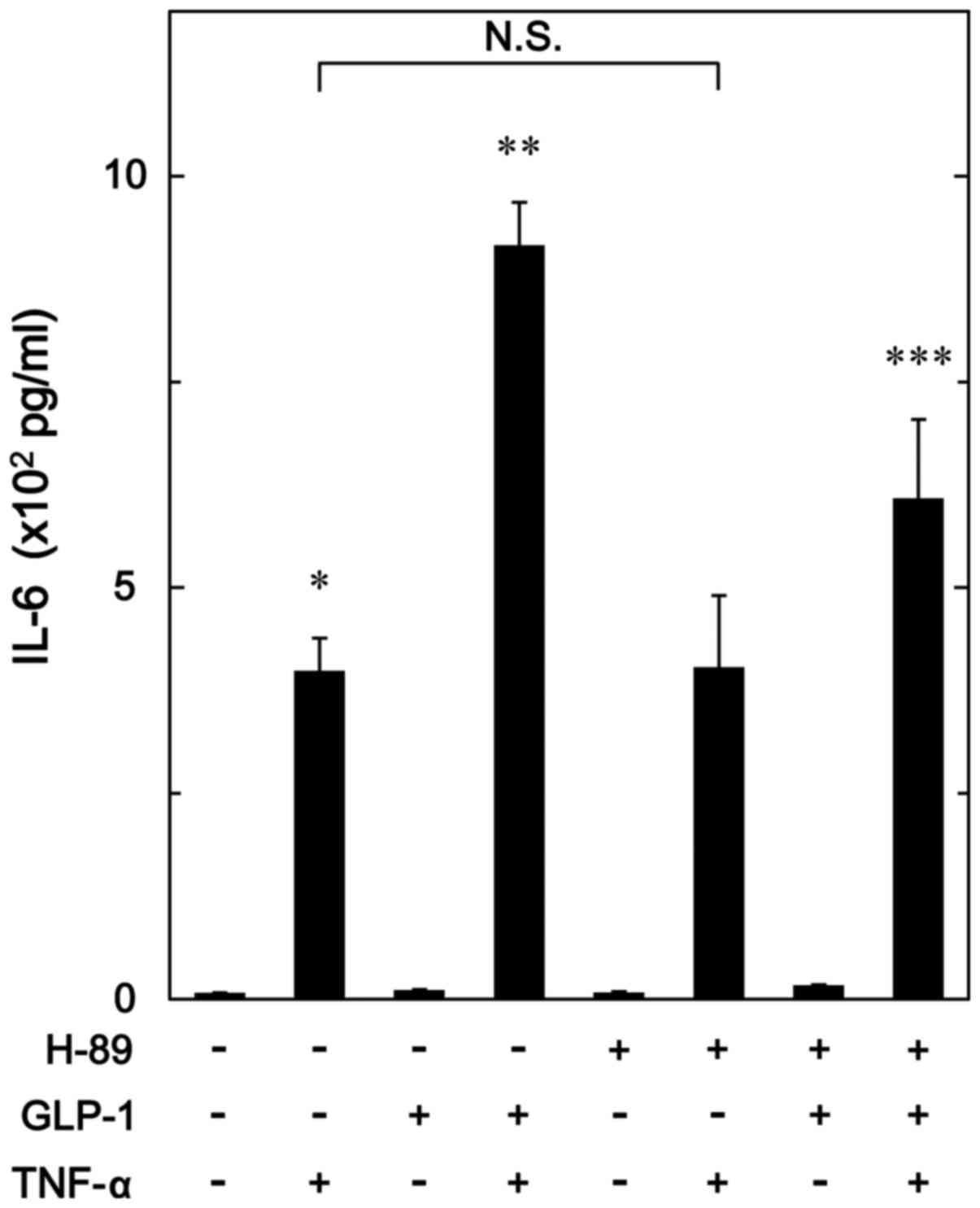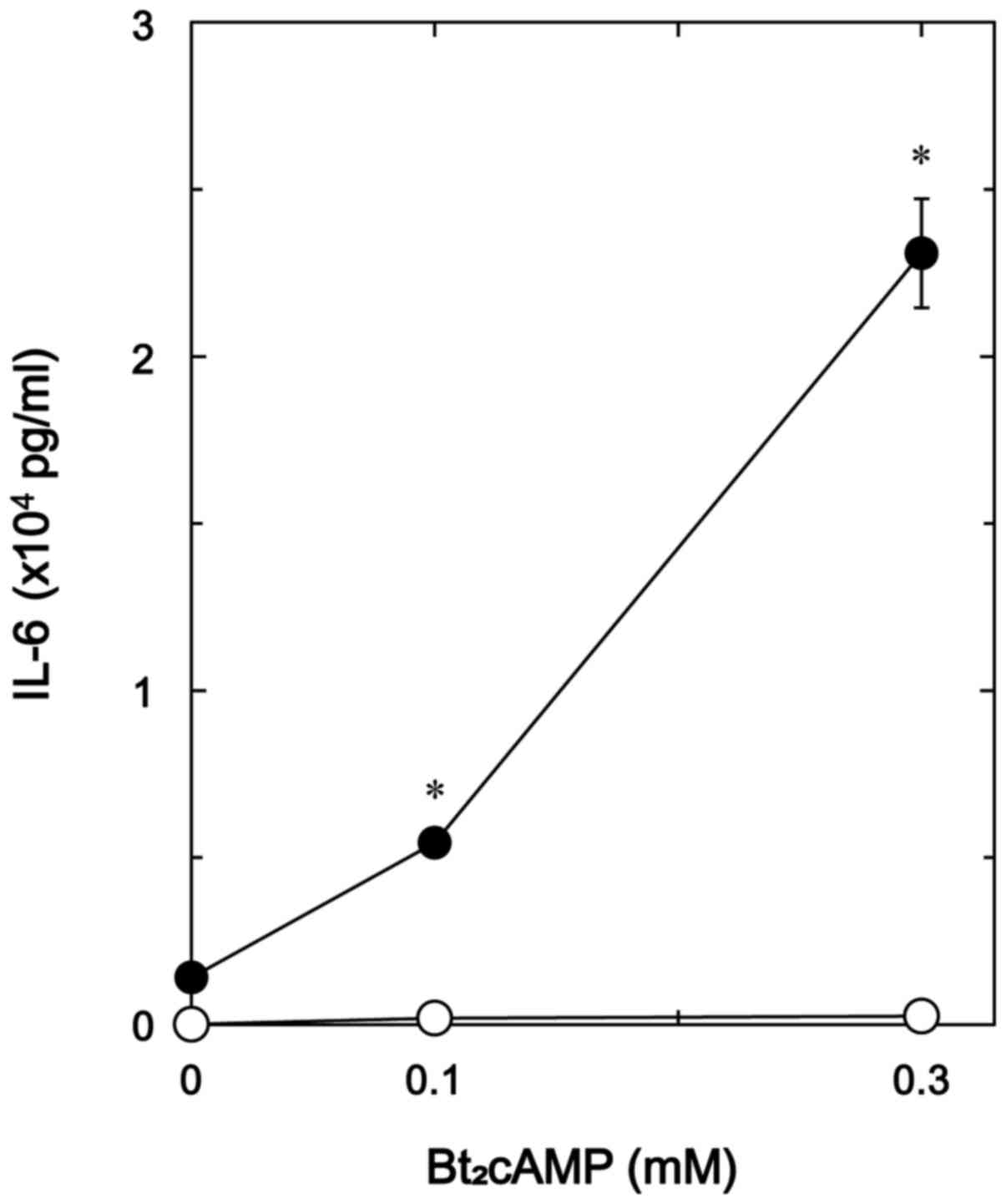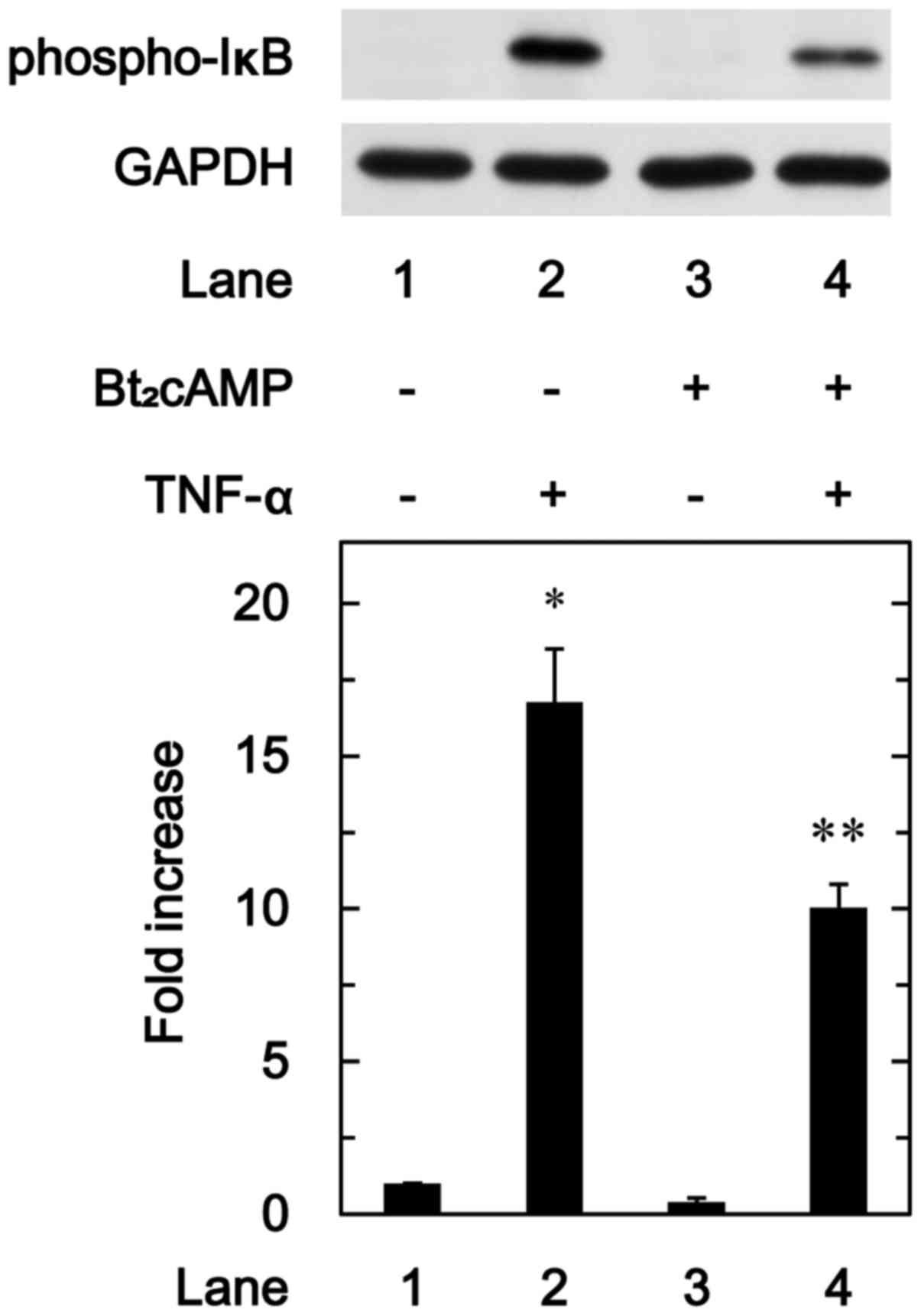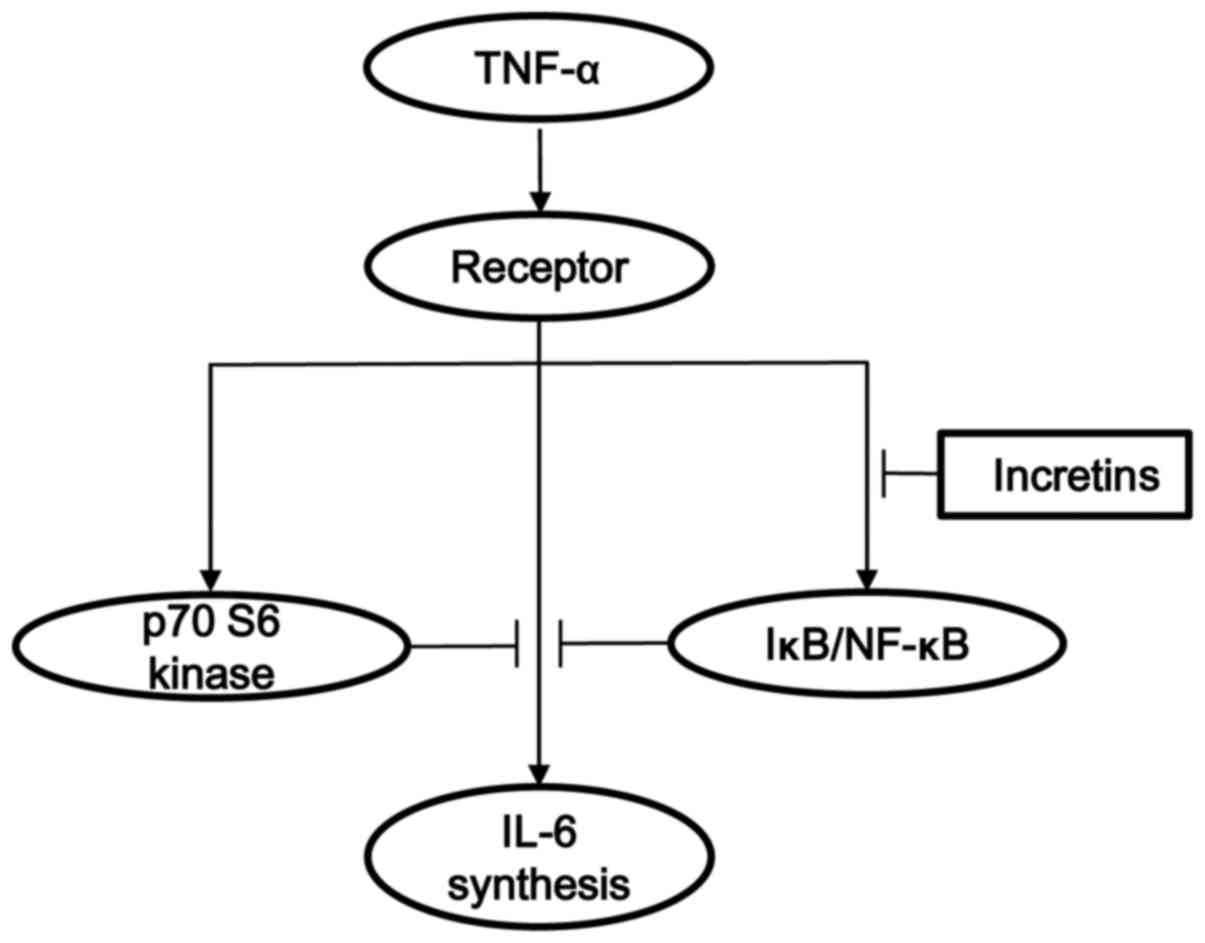Incretins amplify TNF-α-stimulated IL-6 synthesis in osteoblasts: Suppression of the IκB/NF-κB pathway
- Authors:
- Published online on: February 15, 2017 https://doi.org/10.3892/ijmm.2017.2892
- Pages: 1053-1060
Abstract
Introduction
Bone metabolism is strictly controlled by osteoblastic bone formation and osteoclastic bone resorption (1). Bone tissue is continuously regenerated through a process called bone remodeling (2). To maintain adequate quality and quantity of bone, formation and resorption are tightly coordinated. This bone remodeling process begins with osteoclastic bone resorption, followed by osteoblastic bone formation (1). Disruption of the bone remodeling process causes metabolic bone diseases such as osteoporosis or fracture healing distress. It is currently recognized that osteoblasts play a crucial role also in the regulation of bone resorption through the expression of the receptor activator of nuclear factor-κB (RANK) ligand in response to a variety of bone resorptive stimuli (3).
It is firmly established that tumor necrosis factor-α (TNF-α) is a multifunctional cytokine and plays a pivotal role in inflammation, infection and cancer (4). In bone metabolism, TNF-α reportedly induces the activation of RANK in osteoclasts through RANK ligand expression after binding to its specific receptors in osteoblasts, leading to osteoclast activation (5). In addition, it has been shown that TNF-α inhibits the differentiation of osteoblasts from precursor cells (6). Therefore, TNF-α is generally recognized as a potent bone resorptive agent. Regarding the intracellular signaling mechanism of TNF-α, it is well known that TNF-α induces activation of the inhibiting inhibitor of κB (IκB)/nuclear factor-κB (NF-κB) pathway (7). In our previous studies (8,9), we demonstrated that TNF-α stimulated the activation of p70 S6 kinase in osteoblast-like MC3T3-E1 cells, and that the activated p70 S6 kinase negatively regulated TNF-α-stimulated interleukin-6 (IL-6) synthesis. IL-6, a member of the glycoprotein 130 cytokine families (4,10), is well known to stimulate bone resorption and induce osteoclastgenesis (4). It has been shown that IL-6 acts on the osteoblast lineage to stimulate bone formation and maintain strength rather than promoting osteoclast formation (11). Additionally, IL-6 reportedly has a pivotal role in the process of bone fracture repair (12). Therefore, IL-6 secreted by osteoblasts is currently considered as an osteotropic modulator, leading to influencing bone formation under the condition of increased bone remodeling (13). However, the exact mechanism behind the TNF-α-stimulated IL-6 synthesis in osteoblasts remains to be elucidated.
Incretins are designated as small intestine-derived hormones and are released in response to oral food intake (14). Incretins stimulate insulin secretion from pancreatic islet β cells (14,15). Glucose-dependent insulinotropic polypeptide (GIP) and glucagon-like peptide-1 (GLP-1) are generally recognized as two major incretins. GIP and GLP-1 exert their insulinotropic actions through the activation of their specific guanine nucleotide-binding protein (G-protein)-coupled receptors expressed on pancreatic β cells (16). It is generally established that the binding of incretins to their receptors causes the activation of adenylyl cyclase, resulting in the formation of cAMP from ATP (14). Subsequent activation of protein kinase A (PKA) leads into diverse events including altered ion channel activity and elevation of intracellular calcium concentrations (14). With regard to incretin effects on bone, it has been shown that GIP stimulated both collagen type I mRNA expression levels and alkaline phosphatase activity in osteoblasts (17). GIP reportedly increases bone mineral density in an ovariectomized rat model (18). As for GLP-1, it has been demonstrated that GLP-1 receptor-deficient mice presented with an increased number of osteoclasts and bone resorption, and suffered from osteoporosis (19). In addition, GLP-1 reportedly induces the differentiation of osteoblasts (20). However, the details underlying the effects of incretins on bone metabolism have not yet been clarified.
In the present study, we investigated the effects of GLP-1 or GIP on the TNF-α-induced IL-6 synthesis in osteoblast-like MC3T3-E1 cells. We herein showed that GLP-1 and GIP enhanced the TNF-α-stimulated IL-6 synthesis in MC3T3-E1 cells, and that the amplifying effect was exerted via reducing the IκB/NF-κB pathway through the adenylyl cyclase-cAMP system.
Materials and methods
Materials
GLP-1 and GIP were obtained from Peptide Institute, Inc. (Osaka, Japan). TNF-α and mouse IL-6 enzyme-linked immunosorbent assay (ELISA) kit were purchased from R&D System, Inc. (Minneapolis, MN, USA). Dibutyryl cAMP (Bt2cAMP) was obtained from Sigma-Aldrich Co. (St. Louis, MO, USA). Wedelolactone was purchased from Calbiochem (La Jolla, CA, USA). N-[2-(p-bromocinnamylamino)ethyl]-5-isoquinolinesulfonamide (H-89) was obtained from Seikagaku Kogyo Co. (Tokyo, Japan). Phospho-specific IκB, IκB, phospho-specific p70 S6 kinase, p70 S6 and phospho-specific cAMP response element-binding protein (CREB) antibodies were purchased from Cell Signaling Technology, Inc. (Beverly, MA, USA). Glyceraldehyde-3-phosphate dehydrogenase (GAPDH) antibody was obtained from Santa Cruz Biotechnology, Inc. (Santa Cruz, CA, USA). An ECL western blotting detection system was obtained from GE Healthcare Life Sciences (Chalfont, UK). Other materials and chemicals were obtained from commercial sources. Wedelolactone and H-89 were dissolved in dimethyl sulfoxide. The maximum concentration of dimethyl sulfoxide was 0.1%, which did not affect either assay for IL-6 or western blot analysis.
Cell culture
Cloned osteoblast-like MC3T3-E1 cells, which were derived from newborn mouse calvaria (21), were maintained as previously described (22). In brief, the cells were cultured in α-minimum essential medium (α-MEM) containing 10% fetal bovine serum (FBS) at 37°C in a humidified atmosphere of 5% CO2/95% air. The cells were seeded into 35-mm diameter dishes (5×104 cells/dish) or 90-mm diameter dishes (2×105 cells/dish) in α-MEM containing 10% FBS. After 5 days, the medium was exchanged for α-MEM containing 0.3% FBS. The cells were then used for experiments following a 48-h incubation period.
Assay for IL-6
The cultured cells were stimulated by 30 ng/ml of TNF-α or vehicle in 1 ml of α-MEM containing 0.3% FBS for the indicated periods. When indicated, the cells were pretreated with various doses of GLP-1, GIP, wedelo-lactone or Bt2cAMP for 60 min. Pretreatment with H-89 was performed for 60 min prior to the stimulation by GLP-1. The conditioned medium was collected at the end of the incubation, and the IL-6 concentrations in the medium were then measured using the mouse IL-6 ELISA kit according to the manufacturer's protocol.
Real-time RT-PCR
The cultured cells were pretreated with 100 nM of GLP-1, 100 nM of GIP or vehicle for 60 min, and then stimulated by 30 ng/ml TNF-α or vehicle in α-MEM containing 0.3% FBS for 3 h. Total RNA was isolated and transcribed into complementary DNA using TRIzol reagent (Invitrogen; Thermo Fisher Scientific, Inc., Heysham, Lancashire, UK) and the Omniscript Reverse Transcriptase kit (Qiagen Inc., Valencia, CA, USA), respectively. Real-time RT-PCR was performed using a LightCycler system in capillaries and the LightCycler FastStart DNA Master SYBR-Green I provided with the kit (Roche Diagnostics, Basel, Switzerland). Sense and antisense primers for mouse IL-6 mRNA and GAPDH mRNA were synthesized based on the report of Simpson et al (23). The amplified products were determined using a melting curve analysis, according to the system protocol. The levels of IL-6 mRNA were normalized to those of GAPDH mRNA.
Western blot analysis
The cultured cells were pretreated with various concentrations of GLP-1, GIP, wedelolactone or Bt2cAMP for 60 min, and then stimulated by 30 ng/ml of TNF-α or vehicle in α-MEM containing 0.3% FBS for the indicated periods. When indicated, the cells were washed twice with phosphate-buffered saline, and then lysed, homogenized and sonicated in a lysis buffer containing 62.5 mM Tris/HCl, pH 6.8, 2% sodium dodecyl sulfate (SDS), 50 mM dithiothreitol and 10% glycerol. SDS-polyacrylamide gel electrophoresis (PAGE) was performed using the method of Laemmli (24) on 10% polyacrylamide gels. The protein was fractionated and transferred onto an Immun-Blot PVDF membrane (Bio-Rad, Hercules, CA, USA). The membranes were blocked with 5% fat-free dry milk in Tris-buffered saline-Tween (TBS-T; 20 mM Tris-HCl, pH 7.6, 137 mM NaCl, 0.1% Tween-20) for 1 h before incubation with primary antibodies. Western blot analysis was performed as previously described (25) using the indicated primary antibodies with peroxidase-labeled antibodies raised in goat against rabbit IgG being used as secondary antibodies. The primary and secondary antibodies were diluted at 1:1,000 with 5% fat-free dry milk in TBS-T. The peroxidase activity on the PVDF sheet was visualized on X-ray film by means of the ECL western blotting detection system.
Densitometric analysis
The densitometric analysis of western blotting was performed using scanner and image analysis software program (imageJ version 1.48; National Institutes of Health, Bethesda, MD, USA). The phosphorylated protein levels were calculated as follows: the background-subtracted signal intensity of each phosphorylation signal was normalized to the respective intensity of GAPDH or p70 S6 kinase, and plotted as the fold increase in comparison to that of the control cells treated without stimulation.
Statistical analysis
The data were analyzed by ANOVA followed by Bonferroni method for multiple comparisons between pairs, and P<0.05 was considered to indicate a statistically significant difference. All data are presented as the mean ± SEM of triplicate determinations from three independent cell preparations.
Results
Effects of GLP-1 or GIP on the TNF-α-stimulated IL-6 release in MC3T3-E1 cells
In our previous study (8), we demonstrated that TNF-α stimulates IL-6 synthesis via sphingomyelin breakdown in osteoblast-like MC3T3-E1 cells. We first examined the effect of GLP-1, one of the incretins, on the TNF-α-stimulated IL-6 release in MC3T3-E1 cells. GLP-1 significantly amplified the TNF-α-stimulated IL-6 release in a time-dependent manner up to 48 h (Fig. 1A). The enhancing effect of GIP-1 was dose-dependent up to 100 nM (Fig. 1B). The maximum effect of GLP-1 was observed at 0.1 nM, causing ~100% upregulation of the TNF-α effect. In addition, GIP, another incretin, as well as GLP-1 time-dependently enhanced the TNF-α-stimulated IL-6 release in a dose-dependent manner up to 100 nM (Fig. 2A and B). GIP (1 nM) caused a 150% increase in the TNF-α effect (Fig. 2B).
Effects of GLP-1 or GIP on the TNF-α-induced expression of IL-6 mRNA in MC3T3-E1 cells
In order to investigate whether the amplifying effects of GLP-1 and GIP on the TNF-α-stimulated IL-6 release were exerted through transcriptional events, we next examined the effects of GLP-1 or GIP on the TNF-α-induced IL-6 mRNA expression by real-time RT-PCR. Both GLP-1 and GIP, which alone had little effect on the mRNA levels of IL-6, significantly upregulated the expression levels of IL-6 mRNA induced by TNF-α (Fig. 3).
Effect of wedelolactone on the IL-6 release stimulated by TNF-α in MC3T3-E1 cells
It is generally established that cellular responses to TNF-α are mediated through the activation of the IκB/NF-κB pathway (7). In response to TNF-α, IκB is phosphorylated and degraded by IκB kinase, subsequently NF-κB is dissociated with IκB and translocated into the nucleus, resulting in the induction of transcriptional events (26). Therefore, in order to clarify whether the IκB/NF-κB pathway is implicated in the TNF-α-stimulated IL-6 synthesis in osteoblast-like MC3T3-E1 cells, we examined the effect of wedelolactone, a selective inhibitor of IκB kinase (27), on the IL-6 release. We found that wedelolactone truly suppressed the TNF-α-induced phosphorylation of IκB, and restored the decrease of total levels of IκB in the MC3T3-E1 cells (Fig. 4A). On the other hand, wedelolactone markedly enhanced the IL-6 release stimulated by TNF-α dose-dependently in the range between 1 and 30 µM, suggesting that the IκB/NF-κB pathway limits the TNF-α-stimulated IL-6 synthesis (Fig. 4B). Wedelolactone (30 µM) caused an ~200% increase in the TNF-α effect (Fig. 4B).
Effect of GLP-1 on the phosphorylation of p70 S6 kinase induced by TNF-α in MC3T3-E1 cells
We have previously shown that p70 S6 kinase activated by TNF-α negatively regulates IL-6 synthesis in osteoblast-like MC3T3-E1 cells (9). Therefore, in order to investigate whether the effects of incretins on the TNF-α-stimulated IL-6 synthesis are associated with the activation of p70 S6 kinase in these cells, we further examined the effect of GLP-1 on the TNF-α-induced phosphorylation of p70 S6 kinase. However, GLP-1 failed to affect the TNF-α-induced phosphorylation of p70 S6 kinase (Fig. 5A).
Effect of GLP-1 on the phosphorylation of IκB induced by TNF-α in MC3T3-E1 cells
To furthermore clarify whether the effect of GLP-1 on the TNF-α-stimulated IL-6 synthesis is associated with the activation of the IκB/NF-κB pathway in osteoblast-like MC3T3-E1 cells, we examined the effect of GLP-1 on the TNF-α-induced phosphorylation of IκB. GLP-1 significantly attenuated the TNF-α-induced phosphorylation of IκB in a dose-dependent manner between 10 and 100 nM (Fig. 5B).
Effect of GLP-1 on the phosphorylation of CREB in MC3T3-E1 cells
Accumulating evidence suggests that GIP and GLP-1 receptor signaling involves activation of adenylyl cyclase and increases the production of cAMP from ATP, which leads to cAMP-dependent activation of PKA (14). In addition, sustained elevation of cAMP concentrations induces nuclear translocation of the catalytic subunit of the cAMP-dependent PK, leading to CREB activation (28). In order to clarify whether CREB is activated by GLP-1 in osteoblast-like MC3T3-E1 cells, we examined the effect of GLP-1 on the phosphorylation of CREB. GLP-1 markedly induced CREB phosphorylation in the MC3T3-E1 cells, and the effect of GLP-1 reached their peak 20 and 30 min subsequent to the stimulation, respectively, and was reduced thereafter (Fig. 6), suggesting that GLP-1 induces the activation of adenylyl cyclase/cAMP/PKA pathway.
Effect of H-89 on the enhancement by GLP-1 of TNF-α-stimulated IL-6 release in MC3T3-E1 cells
In order to investigate whether PKA activated by GLP-1 amplifies the TNF-α-stimulated IL-6 synthesis in osteoblast-like MC3T3-E1 cells, we examined the effect of H-89, a potent inhibitor of PKA (29), on the enhancement by GLP-1 of the TNF-α-stimulated IL-6 release. H-89, which hardly affected the base line levels of IL-6 release by itself or the levels by TNF-α alone, significantly suppressed the amplification by GLP-1 of the IL-6 release stimulated by TNF-α (Fig. 7).
Effects of Bt2cAMP on the TNF-α-stimulated IL-6 release and the TNF-α-induced phosphorylation of IκB in MC3T3-E1 cells
Additionally, to elucidate whether the effect of GLP-1 on the TNF-α-stimulated IL-6 synthesis is exerted through the adenylyl cyclase/cAMP/PKA pathway in MC3T3-E1 cells, we examined the effect of Bt2cAMP, a permeable analogue of cAMP, on the TNF-α-stimulated IL-6 release. Bt2cAMP markedly amplified the TNF-α-stimulated IL-6 release dose-dependently up to 0.3 mM (Fig. 8).
We further investigated the effect of Bt2cAMP on the phosphorylation of IκB induced by TNF-α in these cells. Bt2cAMP significantly attenuated the TNF-α-induced phosphorylation of IκB (Fig. 9).
Discussion
In the present study, we demonstrated that GLP-1 and GIP, which are well known to stimulate insulin secretion from pancreatic β cells, significantly enhanced the TNF-α-induced release of IL-6 in osteoblast-like MC3T3-E1 cells. Currently, GLP-1 receptor agonists are clinically used for patients with type 2 diabetes. Regarding incretins in bone metabolism, GIP receptors are expressed in osteoblasts (30), and GIP enhances bone formation following binding with GIP receptor (17). On the other hand, GLP-1 reportedly suppressed osteoclastic bone resorption via calcitonin secreted from thyroid parafollicular cells (31). In addition, we showed that the expression levels of IL-6 mRNA induced by TNF-α were amplified by GLP-1 and GIP. Based on our findings, it is most likely that the amplifying effects of GLP-1 or GIP on the TNF-α-stimulated release of IL-6 are mediated through transcriptional levels in osteoblast-like MC3T3-E1 cells. To the best of our knowledge, this is the first report showing that incretins, which alone had no effect on IL-6 synthesis, upregulated the TNF-α-induced IL-6 synthesis in osteoblasts.
We next investigated the exact mechanism underlying the TNF-α-stimulated IL-6 synthesis in osteoblast-like MC3T3-E1 cells. With regard to the intracellular signaling of TNF-α, it is well recognized that TNF-α exerts its cellular effects through activation of the IκB/NF-κB pathway in a variety of cell types including osteoblasts (4). Thus, we investigated whether the IκB/NF-κB pathway is involved in the TNF-α-stimulated IL-6 synthesis in osteoblast-like MC3T3-E1 cells. It is firmly established that IκB binds to NF-κB and inhibits the translocation of NF-κB into the nucleus under unstimulated conditions (32). The phosphorylation of IκB induces the ubiquitination of itself to undergo proteolysis, and subsequent release of NF-κB. The released NF-κB translocates to the nucleus and regulates the process of transcriptional events including IL-6 synthesis (32). In the present study, we showed that wedelolactone, a selective inhibitor of IκB kinase (27), significantly amplified the TNF-α-stimulated IL-6 release in MC3T3-E1 cells. We found that wedelolactone reduced the TNF-α-induced phosphorylation of IκB, suggesting that wedelolactone actually functioned as an inhibitor of IκB kinase. Therefore, these findings suggest that the IκB/NF-κB pathway regulates TNF-α-stimulated IL-6 synthesis, and that the activated pathway plays an inhibitory role in the IL-6 synthesis in osteoblast-like MC3T3-E1 cells. In our previous study (9), we demonstrated that p70 S6 kinase activated by TNF-α limited the IL-6 synthesis in these cells. Based on our findings, it is most likely that the TNF-α-stimulated IL-6 synthesis is negatively regulated by the IκB/NF-κB pathway or p70 S6 kinase in osteoblast-like MC3T3-E1 cells.
We further investigated the precise mechanism underlying the enhancement by incretins of the TNF-α-stimulated IL-6 synthesis in osteoblast-like MC3T3-E1 cells. However, GLP-1 barely affected the phosphorylation of p70 S6 kinase in MC3T3-E1 cells. Therefore, it seems unlikely that the enhancing effect of GLP-1 on the TNF-α-induced IL-6 synthesis is mediated through p70 S6 kinase. On the contrary, we demonstrated that GLP-1 markedly reduced the TNF-α-stimulated phosphorylation of IκB. Therefore, our findings suggest that GLP-1 enhances the TNF-α-stimulated IL-6 synthesis by inhibiting the IκB/NF-κB pathway but not p70 S6 kinase in osteoblast-like MC3T3-E1 cells.
Accumulating evidence indicates that an important intracellular signaling of incretin is the adenylyl cyclase/cAMP/PKA pathway (14,28), and CREB is the first transcriptional regulator targeted by the pathway. In the present study, we showed that GLP-1 markedly induced the phosphorylation of CREB in osteoblast-like MC3T3-E1 cells. Therefore, it seems likely that GLP-1 activates the cAMP/PKA pathway in osteoblast-like MC3T3-E1 cells. We next investigated the involvement of the cAMP/PKA pathway in the enhancement by incretin of the TNF-α-stimulated IL-6 synthesis. H-89, an inhibitor of PKA (29), significantly suppressed the amplification by GLP-1 of the TNF-α-stimulated IL-6 release in MC3T3-E1 cells. Additionally, we demonstrated that Bt2cAMP, a cell-permeable analogue of cAMP, enhanced the TNF-α-stimulated IL-6 release whereas Bt2cAMP significantly suppressed the TNF-α-induced phosphorylation of IκB. Taking our present results into account as a whole, it is most likely that the amplifying effect of GLP-1 on the TNF-α-stimulated IL-6 synthesis is exerted via inhibition of the IκB/NFκ-B pathway through the adenylyl cyclase-cAMP system in osteoblast-like MC3T3-E1 cells. The potential mechanism of incretins in the TNF-α-stimulated IL-6 synthesis in osteoblasts shown here is summarized in Fig. 10.
In bone metabolism, IL-6 has been recognized to act as a bone resorptive agent and to promote osteoclast formation (4). However, IL-6 is currently considered as an osteotropic factor or a bone remodeling mediator under high turnover of bone remodeling, and subsequently stimulates bone formation (13). In bone remodeling, osteoclastic bone resorption is the first step, and subsequently osteoblastic bone formation is induced (33). To maintain adequate quantity and quality of bone, effecient bone remodeling coordinated by osteoclasts and osteoblasts is essential. Taking our present findings into account, it is probable that incretins secreted from the small intestine after nutrient ingestion could affect bone metabolism as an osteotropic modulator through the enhancement of IL-6. On the other hand, in an early stage of bone fracture repair, IL-6 reportedly plays a crucial role in the initiation of bone formation (12). Additionally, evidence is accumulating that incretins stimulate osteoblastic bone formation and maintain bone strength (31). Therefore, our present findings may provide a new significant aspect in the favorable effect of incretins on fracture prevention in elderly persons.
In conclusion, our results strongly suggest that incretins amplify the TNF-α-stimulated IL-6 synthesis in osteoblasts, and that the enhancement by incretins is exerted via inhibition of the IκB/NF-κB pathway through the adenylyl cyclase-cAMP system.
Acknowledgments
We are very grateful to Mrs. Yumiko Kurokawa for her skillful technical assistance. This study was supported in part by a Grant-in-Aid for Scientific Research (grant no. 19591042) from the Ministry of Education, Science, Sports and Culture of Japan, and the Research Funding for Longevity Sciences (grant no. 25-4, 26-12) from the National Center for Geriatrics and Gerontology (Obu, Japan).
References
|
Kular J, Tickner J, Chim SM and Xu J: An overview of the regulation of bone remodelling at the cellular level. Clin Biochem. 45:863–873. 2012. View Article : Google Scholar : PubMed/NCBI | |
|
Chim SM, Tickner J, Chow ST, Kuek V, Guo B, Zhang G, Rosen V, Erber W and Xu J: Angiogenic factors in bone local environment. Cytokine Growth Factor Rev. 24:297–310. 2013. View Article : Google Scholar : PubMed/NCBI | |
|
Boyce BF and Xing L: Functions of RANKL/RANK/OPG in bone modeling and remodeling. Arch Biochem Biophys. 473:139–146. 2008. View Article : Google Scholar : PubMed/NCBI | |
|
Kwan Tat S, Padrines M, Théoleyre S, Heymann D and Fortun Y: IL-6, RANKL, TNF-alpha/IL-1: Interrelations in bone resorption pathophysiology. Cytokine Growth Factor Rev. 15:49–60. 2004. View Article : Google Scholar : PubMed/NCBI | |
|
Zou W, Hakim I, Tschoep K, Endres S and Bar-Shavit Z: Tumor necrosis factor-α mediates RANK ligand stimulation of osteoclast differentiation by an autocrine mechanism. J Cell Biochem. 83:70–83. 2001. View Article : Google Scholar : PubMed/NCBI | |
|
Gilbert L, He X, Farmer P, Boden S, Kozlowski M, Rubin J and Nanes MS: Inhibition of osteoblast differentiation by tumor necrosis factor-α. Endocrinology. 141:3956–3964. 2000.PubMed/NCBI | |
|
Puimège L, Libert C and Van Hauwermeiren F: Regulation and dysregulation of tumor necrosis factor receptor-1. Cytokine Growth Factor Rev. 25:285–300. 2014. View Article : Google Scholar : PubMed/NCBI | |
|
Kozawa O, Suzuki A, Kaida T, Tokuda H and Uematsu T: Tumor necrosis factor-alpha autoregulates interleukin-6 synthesis via activation of protein kinase C. Function of sphingosine 1-phosphate and phosphatidylcholine-specific phospholipase C. J Biol Chem. 272:25099–25104. 1997. View Article : Google Scholar : PubMed/NCBI | |
|
Minamitani C, Tokuda H, Adachi S, Matsushima-Nishiwaki R, Yamauchi J, Kato K, Natsume H, Mizutani J, Kozawa O and Otsuka T: p70 S6 kinase limits tumor necrosis factor-α-induced interleukin-6 synthesis in osteoblast-like cells. Mol Cell Endocrinol. 315:195–200. 2010. View Article : Google Scholar | |
|
Hirano T, Yasukawa K, Harada H, Taga T, Watanabe Y, Matsuda T, Kashiwamura S, Nakajima K, Koyama K, Iwamatsu A, et al: Complementary DNA for a novel human interleukin (BSF-2) that induces B lymphocytes to produce immunoglobulin. Nature. 324:73–76. 1986. View Article : Google Scholar : PubMed/NCBI | |
|
Johnson RW, Brennan HJ, Vrahnas C, Poulton IJ, McGregor NE, Standal T, Walker EC, Koh TT, Nguyen H, Walsh NC, et al: The primary function of gp130 signaling in osteoblasts is to maintain bone formation and strength, rather than promote osteoclast formation. J Bone Miner Res. 29:1492–1505. 2014. View Article : Google Scholar | |
|
Fazzalari NL: Bone fracture and bone fracture repair. Osteoporos Int. 22:2003–2006. 2011. View Article : Google Scholar : PubMed/NCBI | |
|
Franchimont N, Wertz S and Malaise M: Interleukin-6: An osteotropic factor influencing bone formation? Bone. 37:601–606. 2005. View Article : Google Scholar : PubMed/NCBI | |
|
Holst JJ: The physiology of glucagon-like peptide 1. Physiol Rev. 87:1409–1439. 2007. View Article : Google Scholar : PubMed/NCBI | |
|
Meier C, Schwartz AV, Egger A and Lecka-Czernik B: Effects of diabetes drugs on the skeleton. Bone. 82:93–100. 2016. View Article : Google Scholar | |
|
Baggio LL and Drucker DJ: Biology of incretins: GLP-1 and GIP. Gastroenterology. 132:2131–2157. 2007. View Article : Google Scholar : PubMed/NCBI | |
|
Bollag RJ, Zhong Q, Phillips P, Min L, Zhong L, Cameron R, Mulloy AL, Rasmussen H, Qin F, Ding KH, et al: Osteoblast-derived cells express functional glucose-dependent insulinotropic peptide receptors. Endocrinology. 141:1228–1235. 2000.PubMed/NCBI | |
|
Bollag RJ, Zhong Q, Ding KH, Phillips P, Zhong L, Qin F, Cranford J, Mulloy AL, Cameron R and Isales CM: Glucose- dependent insulinotropic peptide is an integrative hormone with osteotropic effects. Mol Cell Endocrinol. 177:35–41. 2001. View Article : Google Scholar : PubMed/NCBI | |
|
Yamada C, Yamada Y, Tsukiyama K, Yamada K, Udagawa N, Takahashi N, Tanaka K, Drucker DJ, Seino Y and Inagaki N: The murine glucagon-like peptide-1 receptor is essential for control of bone resorption. Endocrinology. 149:574–579. 2008. View Article : Google Scholar | |
|
Sanz C, Vázquez P, Blázquez C, Barrio PA, Alvarez MM and Blázquez E: Signaling and biological effects of glucagon-like peptide 1 on the differentiation of mesenchymal stem cells from human bone marrow. Am J Physiol Endocrinol Metab. 298:E634–E643. 2010. View Article : Google Scholar | |
|
Sudo H, Kodama HA, Amagai Y, Yamamoto S and Kasai S: In vitro differentiation and calcification in a new clonal osteogenic cell line derived from newborn mouse calvaria. J Cell Biol. 96:191–198. 1983. View Article : Google Scholar : PubMed/NCBI | |
|
Kozawa O, Tokuda H, Miwa M, Kotoyori J and Oiso Y: Cross-talk regulation between cyclic AMP production and phosphoinositide hydrolysis induced by prostaglandin E2 in osteoblast-like cells. Exp Cell Res. 198:130–134. 1992. View Article : Google Scholar : PubMed/NCBI | |
|
Simpson DA, Feeney S, Boyle C and Stitt AW: Retinal VEGF mRNA measured by SYBR green I fluorescence: A versatile approach to quantitative PCR. Mol Vis. 6:178–183. 2000.PubMed/NCBI | |
|
Laemmli UK: Cleavage of structural proteins during the assembly of the head of bacteriophage T4. Nature. 227:680–685. 1970. View Article : Google Scholar : PubMed/NCBI | |
|
Kato K, Ito H, Hasegawa K, Inaguma Y, Kozawa O and Asano T: Modulation of the stress-induced synthesis of hsp27 and α B-crystallin by cyclic AMP in C6 rat glioma cells. J Neurochem. 66:946–950. 1996. View Article : Google Scholar : PubMed/NCBI | |
|
Hehlgans T and Pfeffer K: The intriguing biology of the tumour necrosis factor/tumour necrosis factor receptor superfamily: Players, rules and the games. Immunology. 115:1–20. 2005. View Article : Google Scholar : PubMed/NCBI | |
|
Kobori M, Yang Z, Gong D, Heissmeyer V, Zhu H, Jung YK, Gakidis MA, Rao A, Sekine T, Ikegami F, et al: Wedelolactone suppresses LPS-induced caspase-11 expression by directly inhibiting the IKK complex. Cell Death Differ. 11:123–130. 2004. View Article : Google Scholar | |
|
Yu Z and Jin T: New insights into the role of cAMP in the production and function of the incretin hormone glucagon-like peptide-1 (GLP-1). Cell Signal. 22:1–8. 2010. View Article : Google Scholar | |
|
Chijiwa T, Mishima A, Hagiwara M, Sano M, Hayashi K, Inoue T, Naito K, Toshioka T and Hidaka H: Inhibition of forskolin-induced neurite outgrowth and protein phosphorylation by a newly synthesized selective inhibitor of cyclic AMP-dependent protein kinase, N-[2-(p-bromocinnamylamino) ethyl]-5-isoquinolinesulfonamide (H-89), of PC12D pheochromocytoma cells. J Biol Chem. 265:5267–5272. 1990.PubMed/NCBI | |
|
Nuche-Berenguer B, Portal-Núñez S, Moreno P, González N, Acitores A, López-Herradón A, Esbrit P, Valverde I and Villanueva-Peñacarrillo ML: Presence of a functional receptor for GLP-1 in osteoblastic cells, independent of the cAMP-linked GLP-1 receptor. J Cell Physiol. 225:585–592. 2010. View Article : Google Scholar : PubMed/NCBI | |
|
Seino Y and Yabe D: Glucose-dependent insulinotropic polypeptide and glucagon-like peptide-1: Incretin actions beyond the pancreas. J Diabetes Investig. 4:108–130. 2013. View Article : Google Scholar : PubMed/NCBI | |
|
Hoffmann A and Baltimore D: Circuitry of nuclear factor-κB signaling. Immunol Rev. 210:171–186. 2006. View Article : Google Scholar : PubMed/NCBI | |
|
Karsenty G and Wagner EF: Reaching a genetic and molecular understanding of skeletal development. Dev Cell. 2:389–406. 2002. View Article : Google Scholar : PubMed/NCBI |



